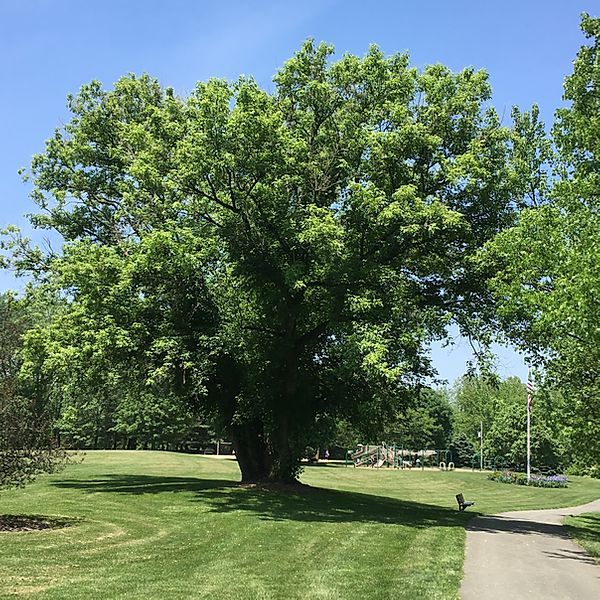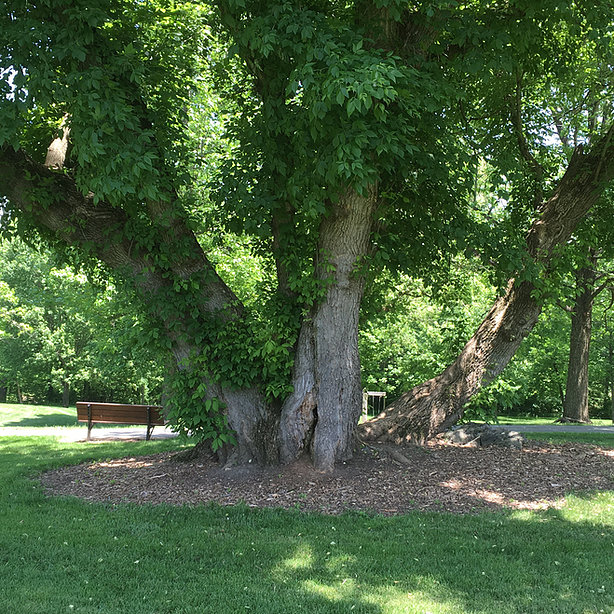A Word About Measuring Tree Size
American Forests, the conservation organization that administers the National Big Tree Program, has developed a deceptively simple formula to measure a tree’s size. Three aspects of a given tree are considered: (1) The circumference of the trunk; (2) the tree’s height; and (3) the spread of the tree’s branches. Once these three figures are obtained, a tree is given one point for each inch of circumference, one point for each foot of height, and one point for every four feet of spread.
Thus a tree that is 150 inches in circumference, 100 feet in height, and 80 feet in spread would have a point total of 150 + 100 + 20 = 270. This number can then be compared to the point total of other trees to determine which specimen is largest. [Two trees can be co-champions, as deter- mined by the 3×3 Rule. Under this rule — which not everyone uses — co-champions are designated if (a) their point total is less than 100 and within 3 of each other; or (b) their point total is more than 100 and within 3% of each other.]
While simple in structure, the Tree-Size Formula can be difficult to apply. Spread is fairly easy for an untrained individual to determine, but height is less easy to pin down and trunk circumference is not always easy to define….in particular, in terms of where along the trunk to measure and how to deal with multi-trunked trees.
Multi-trunked trees are especially a problem. A single tree can, early in its life, branch off into two or more trunks. Alternatively, two or more trees of the same species can sprout next to each other (as when a seed pod falls in its entirety to the ground) and then fuse over time, giving the appear- ance of a single tree when in fact beginning life as several individuals. If you’re focused on whether a tree is a champion (e.g., the largest of its kind within a given state), then obviously you don’t want to compare a single trunked tree to one in which several individuals have joined together. That just wouldn’t be fair.
Such matters are not of prime concern to us here. Sure, it’s interesting and important to know that the Burr Oak in Millersville has been determined to be the largest Burr Oak in Pennsylvania. But what about the Boxelder Maple in Manor Township Community Park whose multiple trunks start spreading basically at ground-level? Even though it may not fit the standards of a “big tree” list, any passerby will tell you that however it began life and however many trunks it has, it’s a single tree today and an especially large one at that.
Point being, even when our focus is on size (as opposed to form, beauty, etc.), multi-trunked trees are as welcome here as any other special tree in Lancaster County.
A few other points should be made about AF’s Tree-Size Formula (i.e., # inches of trunk circum- ference + # feet of height + 1/4 the # of feet of spread). First, although the formula is quite brilliant — it’s easy to comprehend, fairly easy to apply (for professionals at least), and neatly permits comparisons between trees — it is nevertheless an arbitrary formula. A different but equally logical formula would produce different results. For example, the AF formula de-emphasizes a tree’s spread compared to its height by requiring that the former be divided by 4. Logically, spread has as much to do with the size of a tree as its height does, so why minimize the effects of spread?
This aspect of the AF formula can affect the point totals that trees attain. Old Sycamore in Cen- terville (see entry) has a trunk circumference of 300 inches, a height of 70 feet, and a spread of 117 feet for a point total of 399. It is thus 7 points less than a sycamore in Langhorne PA which has a trunk circumference of 294 inches, a height of 87 feet, and a spread of 99 feet for a point total of 406. However, if each foot of spread counted as a point just as each foot of height does, Old Sycamore would have 487 points, or 7 points more than the 480 points of the Langhorne tree.
A second issue is that AF’s Tree-Size Formula obviously does not measure the whole tree. This is by necessity, yet it bears remembering that, like icebergs, a large part of any tree is out of sight beneath the surface. Indeed, as much as 30% of a tree’s biomass is composed of its root system. Furthermore, a tree’s roots can in some cases extend outward four times the spread of the tree’s crown. There is of course no practical way to measure a living tree’s roots and so AF’s formula has to treat this very significant part of a tree as if it didn’t exist. But the point is that no matter how carefully we measure a tree, and no matter which tree-size formula we use, we can’t even come close to gauging the plant as a whole.
American Forests, the conservation organization that administers the National Big Tree Program, has developed a deceptively simple formula to measure a tree’s size. Three aspects of a given tree are considered: (1) The circumference of the trunk; (2) the tree’s height; and (3) the spread of the tree’s branches. Once these three figures are obtained, a tree is given one point for each inch of circumference, one point for each foot of height, and one point for every four feet of spread.
Thus a tree that is 150 inches in circumference, 100 feet in height, and 80 feet in spread would have a point total of 150 + 100 + 20 = 270. This number can then be compared to the point total of other trees to determine which specimen is largest. [Two trees can be co-champions, as deter- mined by the 3×3 Rule. Under this rule — which not everyone uses — co-champions are designated if (a) their point total is less than 100 and within 3 of each other; or (b) their point total is more than 100 and within 3% of each other.]
While simple in structure, the Tree-Size Formula can be difficult to apply. Spread is fairly easy for an untrained individual to determine, but height is less easy to pin down and trunk circumference is not always easy to define….in particular, in terms of where along the trunk to measure and how to deal with multi-trunked trees.
Multi-trunked trees are especially a problem. A single tree can, early in its life, branch off into two or more trunks. Alternatively, two or more trees of the same species can sprout next to each other (as when a seed pod falls in its entirety to the ground) and then fuse over time, giving the appear- ance of a single tree when in fact beginning life as several individuals. If you’re focused on whether a tree is a champion (e.g., the largest of its kind within a given state), then obviously you don’t want to compare a single trunked tree to one in which several individuals have joined together. That just wouldn’t be fair.
Such matters are not of prime concern to us here. Sure, it’s interesting and important to know that the Burr Oak in Millersville has been determined to be the largest Burr Oak in Pennsylvania. But what about the Boxelder Maple in Manor Township Community Park whose multiple trunks start spreading basically at ground-level? Even though it may not fit the standards of a “big tree” list, any passerby will tell you that however it began life and however many trunks it has, it’s a single tree today and an especially large one at that.
Point being, even when our focus is on size (as opposed to form, beauty, etc.), multi-trunked trees are as welcome here as any other special tree in Lancaster County.
A few other points should be made about AF’s Tree-Size Formula (i.e., # inches of trunk circum- ference + # feet of height + 1/4 the # of feet of spread). First, although the formula is quite brilliant — it’s easy to comprehend, fairly easy to apply (for professionals at least), and neatly permits comparisons between trees — it is nevertheless an arbitrary formula. A different but equally logical formula would produce different results. For example, the AF formula de-emphasizes a tree’s spread compared to its height by requiring that the former be divided by 4. Logically, spread has as much to do with the size of a tree as its height does, so why minimize the effects of spread?
This aspect of the AF formula can affect the point totals that trees attain. Old Sycamore in Cen- terville (see entry) has a trunk circumference of 300 inches, a height of 70 feet, and a spread of 117 feet for a point total of 399. It is thus 7 points less than a sycamore in Langhorne PA which has a trunk circumference of 294 inches, a height of 87 feet, and a spread of 99 feet for a point total of 406. However, if each foot of spread counted as a point just as each foot of height does, Old Sycamore would have 487 points, or 7 points more than the 480 points of the Langhorne tree.
A second issue is that AF’s Tree-Size Formula obviously does not measure the whole tree. This is by necessity, yet it bears remembering that, like icebergs, a large part of any tree is out of sight beneath the surface. Indeed, as much as 30% of a tree’s biomass is composed of its root system. Furthermore, a tree’s roots can in some cases extend outward four times the spread of the tree’s crown. There is of course no practical way to measure a living tree’s roots and so AF’s formula has to treat this very significant part of a tree as if it didn’t exist. But the point is that no matter how carefully we measure a tree, and no matter which tree-size formula we use, we can’t even come close to gauging the plant as a whole.
For detailed, technical information on measuring trees, see guidelines of the Eastern Native Tree Society at https://www.nativetreesociety.org/measure/tree_measuring_guidelines.htm or consult the American Forests Measuring Guidelines Handbook at https://www.americanforests.org/wp-content/uploads/2014/12/AF-Tree-Measuring-Guidelines_LR.pdf

